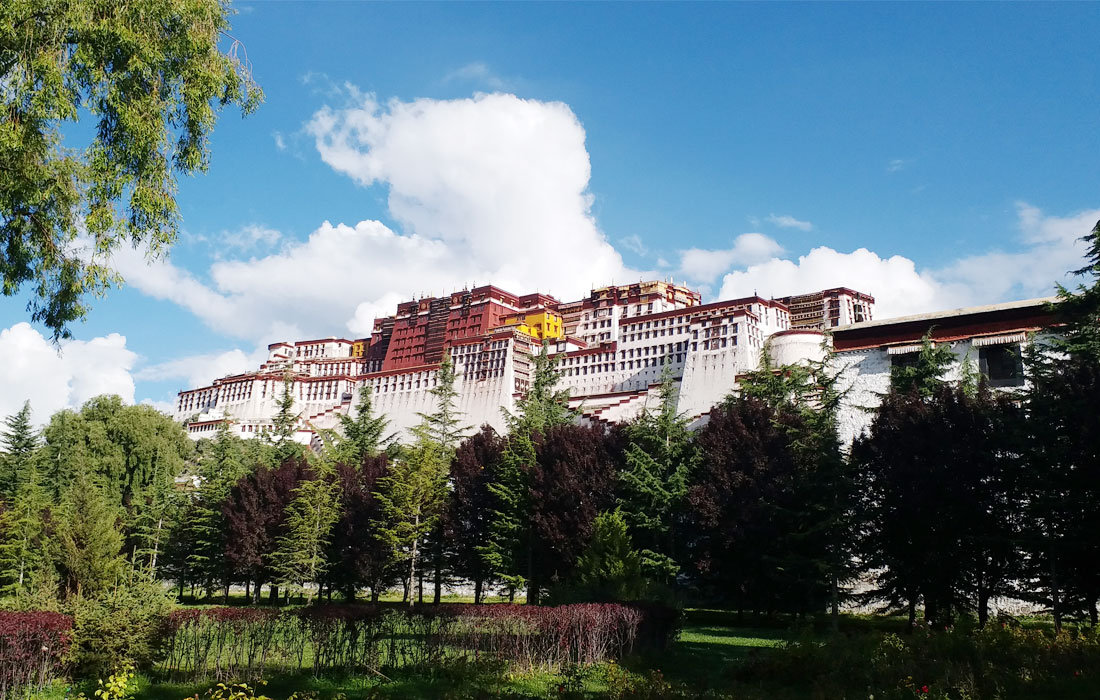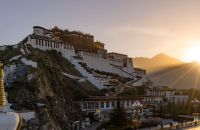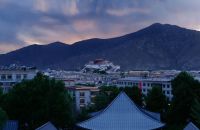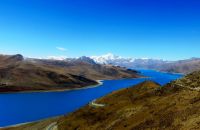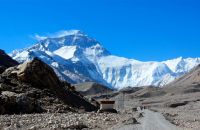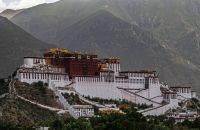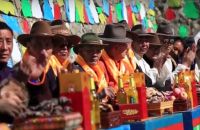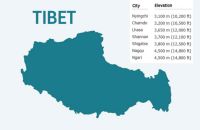Talk with our local travel specialist who can help organize your trip.
Best Places to Visit in Tibet
Tibet, a region hidden from the rest of the world for centuries, is the world’s highest tourist destination. The spiritual home of the Dalai Lama and ancient Buddhist monasteries, Tibet is an inspiration for those travelers seeking a unique experience. Filled with cultural and historical treasures like the Potala Palace and Jokhang Temple and natural wonders like the Everest Base Camp and Mount Kailash, the Tibetan plateau is the ultimate holiday destination.
Known as the ‘Roof of the World’, Tibet is the highest Himalayan destination in the world. With an average elevation of around 5000 metres, the Tibetan highland is by far the world’s highest inhabited region. Its arid landscape dotted with majestic palaces, sacred monasteries, Buddhist shrines, nomadic settlements and mountain lakes, has inspired travelers to explore this mystical destination.
This sparsely populated region has some of the oldest Buddhist monasteries as well as a modern railway system - the Qinghai-Tibet Railway, the world’s highest railway line. The north face of Mount Everest, the highest mountain in the world, also lies in Tibet. Some of the important cities in Tibet include Lhasa, Shigatse, Gyantse and Tsetang. Apart from the cultural and historical sites, such as the Potala Palace, Jokhang Temple, Drepung Monastery and Samye Monastery, natural wonders like the, Yamdrok Tsho Lake, Everest Base Camp, Mount Kailash and Mansarover Lake continue to attract visitors to Tibet.
Lhasa
Lhasa, which means the ‘Place of Gods’ in Tibetan, is the capital of Tibet. Situated at an elevation of 3656 metres, the city has the only international airport in the region, Lhasa Gonggar Airport. The foundation of the city was laid in the seventh century by the Tibetan emperor Songsten Gampo who is also credited with the building of the Jokhang Temple. Lhasa became the political and administrative centre when the 5th Dalai Lama Lobsang Gyatso rebuilt the city and moved the capital to Lhasa. Since then the city has continued to be the political, religious and economic hub of the region. Lying in a deep valley surrounded by the Marpori, Chakpori and Barmari hills, beside the Lhasa river, this picturesque city remains generally sunny throughout the year. Some of the must-visit attractions in Lhasa are:
Potala Palace
Set on the Red Mountain, the magnificent Potala Palace rises above the city of Lhasa. This iconic palace was built on the remains of an old palace built by Tibetan Emperor Songtsen Gampo. The Potala Palace was constructed in the seventeenth century during the time of the fifth Dalai Lama. After its construction, the Potala Palace served as the winter residence of the Dalai Lama, until the 14th Dalai Lama’s exile from Tibet.
A UNESCO World Heritage Site, the palace has been converted into a museum. The gigantic Potala Palace is divided into the Red Palace and the White Palace. While the White Palace houses the Dalai Lama’s private chambers, the throne room and assembly hall, the Red Palace houses the tombs of the former Dalai Lamas and a private monastery.
One can discover around 10,000 Thangkas (traditional Tibetan scroll paintings), 698 murals, ancient artifacts including relics made from precious metals and stones and collection of rare Buddhist sutras.
Jokhang Temple
Jokhang Temple is one of the oldest Buddhist temples in Tibet. Located in Lhasa, the temple was built during the reign of Emperor Songsten Gampo. The temple was constructed to house the statues of Buddha brought by his two wives – Princess Bhrikuti from Nepal and Princess Wencheng from China.
The oldest part of the temple dates back to 652 AD. The temple showcases over 3000 images of Lord Buddha and rare Buddhist religious texts. The walls of the temple are covered with beautiful murals depicting scenes from the life of Lord Buddha and Buddhist deities.
Norbulingka
Constructed in the 18th century, the Norbulingka served as the Summer Palace of the Dalai Lama. This delightful palace, filled with beautiful gardens, ornamental ponds and fountains, is located on the western part of Lhasa, on the banks of the Kyichu or Lhasa River. A UNESCO World Heritage Site, the palace complex has four palaces and a monastery and decorative pavilions.
Tibetan families usually love to spend their leisure hours sitting at the grassy lawn of this beautiful palace. The Shoton Festival or the Yoghurt Festival is celebrated on the grounds of the Norbulingka Palace. The festival is celebrated on the seventh month of the Tibetan lunar calendar (July or August). This is a week-long festival and people celebrate it by merry-making and feasting. Traditional Tibetan operas and cultural performances are held in the garden area of the Summer Palace.
Barkhor Square
Barkhor Square is the economic hub of Lhasa. It lies at the centre of the city, lined with shops, restaurants and cafes. While walking around the square, you will find a lot of Tibetan pilgrims prostrating and circumambulating around the Jokhang Temple that lies at the middle of the square.
Barkhor Square is a good place to observe the locals and the local traders. This has been an important spot for Tibetans living in Lhasa as this is where they to congregate to observe important occasions since the square came into existence. Take your camera with you when you visit Barkhor Square, as the place which buzzes with activity, offers plenty of photo opportunities.
Sera Monastery
Sera Monastery is one of Tibet’s most important Gelug monasteries. Located around two kilometers north of Lhasa. , It is an ancient university monastery where monks receive higher education from learned lamas. The monastery was founded in 1419 by Jamchen Chojay Sakya Yeshe, a disciple of Lama Tsongkhapa (the founder of the Gelugpa Sect).
‘Sera’ in Tibetan means ‘wild rose’. The monastery was named Sera because there were a lot of wild roses blooming around the hill where the monastery was built. The huge monastery is divided into three sections – the assembly hall, the college where the monks receive education and the dormitories or the living and dining quarters of the monks.
The monastery is known for its lively debates. Monks at Sera Monastery are required to take part in debates as part of their training. The senior monks fire various questions related to the Buddhist doctrines to junior monks, who are expected to respond after the senior monk claps his hands. The debates take place at an open courtyard and are often noisy and punctuated with repeated hand claps.
Ganden Monastery
Ganden monastery is one of the three important Gelug monasteries in Tibet. Lying about 40 kilometres northeast of Lhasa, this ancient monastery was built in 1409 by the founder of the Gelug order, Je Tsongkhapa Lozang-Drakpa. His remains is entombed inside the monastery in a gold and silver tomb.
Situated on top of the Wangbur Mountain, Gsnden Monastery was heavily damaged during the Cultural Revolution by Chinese armies. This magnificent structure was bombed and its chapels were destroyed. At that time, the monastery housed more than 12 major chapels and a prayer hall with a capacity of seating 3,500 monks.
Though not as grand and majestic as it was earlier, Ganden Monastery which has been rebuilt and renovated in the recent years, still instills a sense of awe and wonder among visitors. The three main sites which are popular among tourists include the Tsokchen Assembly Hall, Serdung where the tomb of the revered Tsongkhapa lies and Ngam Cho Khang, the chapel where the Tsongkhapa gave his sermons. The monastery has a visitor’s guesthouse for people who wish to stay overnight at the monastery.
Drepung Monastery
Located around eight kilometers west of Lhasa, at the foot of Mount Gephel is Drepung Monastery. Drepung means ‘rice heap’ in Tibetan. The monastery was named ‘Drepung’ because its white buildings looked like ‘rice heaps’ on the brown hillside.
One of the largest and an important Gelugpa monastery, Drepung Monastery was founded in 1416 by Jamyang Choge Tashi Palden. At the height of its popularity it was the largest Buddhist monastery in the world and housed more than 7,000 monks. Many learned monks residing at this monastery created important Buddhist literature. The Ganden Phodrang at the monastery used to be the official residence of the Dalai Lama before the building of the Potala Palace.
The large monastery occupies several acres of land. It is divided into a large assembly hall (Coqen), seven colleges or Zacangs (Loseling, Gomang, Deyang, Shagkor, Gyalpa, Dulwa and Ngagpa) and the living quarters or Kamcuns of the monks residing at the monastery. This historic monastery houses some of the most important Buddhist relics and statues, including a conch that once belonged to Sakyamuni Buddha. The best way to explore this monastery is to follow the pilgrim’s route. It takes around three to four hours to explore the whole complex.
Tibetan Traditional Hospital
Mentsekhang or Tibetan Traditional Hospital, established in 1916, is a production and research centre of traditional Tibetan medicine. The Tibetan traditional method of healing takes into account seasonal changes, lunar and planetary placements and the natural environment to diagnose and treat ailments. Tibetan medicine is formulated using natural herbs and organic matter.
With an area of 40,000 sq meters the hospital is the largest traditional hospital and production unit of Tibetan medicine in the region. It has its own medicine factory and training and research centre. Various ailments related to blood, bones, brain and other internal organs are treated at this hospital.
Recommended Read - Festivals In Tibet - Tibetan Festival Calendar 2020/2021
Shigatse
Located southwest of Lhasa, Shigatse is the second largest city in Tibet Autonomous Region of China. It is home to the Panchen Lama, the second most important leader of the Tibetans after Dalai Lama. Lying at an altitude 3,800 metres, the city is the capital of the Tsang province. Some of the major landmarks in the city include Shigatse Dzong, Tashilhunpo Monastery, Summer Palace of Panchen Lama, Sakya Monastery etc. The incredible Rongbuk glacier, Rongbuk Monastery and Everest Base Camp are also located in Shiagtse.
Tashilhunpo Monastery
Tashilhunpo Monastery is one of the most important monasteries in Tibet. It is the seat of the Panchen Lama, a tulku or supreme teacher of the Gelug tradition, The Lama is the second most important spiritual guide after Dalai Lama. It is the Panchen Lama in fact, who is responsible for choosing the Dalai Lama.
The Tashilhunpo Monastery was founded in 1447 by the first Dalai Lama. Unlike other monasteries in Tibet, this monastery suffered negligible damages during the Cultural Revolution. The marauding Chinese army left most of it undisturbed due to the Panchen Lama’s close ties with China.
Tashilhunpo Monastary is located on the slopes of Nyiseri mountain, in the western part of Shigatse. This magnificent Gelugpa monastery covers an area of 70,000 sq metres and is currently the largest active monastery in Tibet. It is home to more than 900 monks.
Some of the major highlights of the Tashilhunpo Monastery include Jamkhang Chenmo or Chapel or Jampa, with the 26m tall statue of Maitreyi (Jampa), the Future Buddha, Namgyal Lhakhang or Victory Chapel, tombs of the Panchen Lamas, assembly hall and Tantric College.
Shigatse Dzong
Shigatse Dzong which is also known as Samdruptse Dzong was built by Karma Phuntsok Namgyal, a scion of the Tsangpa dynasty who ruled over Tibet from 1565 to 1642. Overlooking the city of Shigatse, this impressive dzong (fortress) was destroyed during the Cultural Revolution. At present only a few ramparts from the original structure remains. A new castle has been rebuilt at the original site.
Sakya Monastery
Located 127km west of Shigatse, Sakya Monastery is one of the oldest Buddhist monasteries in the world. It was established in 1073 by Konchok Gyalpo, the first Sakya trizin. The Sakya Monastery serves as the seat of the Sakyapa school of Tibetan Buddhism.
The large monastery is home to ancient thangkas, Buddhist relics and an extensive collection of ancient Buddhist manuscripts, including the world’s largest religious scripture – the Burde Gyamalung (6ft long, 4ft wide and 2ft thick) weighing an incredible 500kg.
Sakya Monastery has preserved the teachings of learned Buddhist saints and gurus who had travelled all the way from India to Tibet to spread Buddha’s teachings. The monastery is an important centre for learning the ten scientific disciplines taught by the Indian gurus.
Rongbuk Monastery
Rongbuk Monastery, which lies at an altitude of 5100 metres, is the world’s highest Buddhist monastery. The monastery, which is situated in Shigatse Prefecture, was founded in 1902 by Ngawang Tenzing Norbu, a Nyingmapa lama. It is an important pilgrimage site, not only for Buddhists living in that area, but also for the Sherpas living on the Nepalese or south side of the mountain.
The monastery was destroyed during the Cultural Revolution, but has since been rebuilt. Rongbuk Monastery has close ties to Sherpas living in the Khumbu Region in Nepal. Some important manuscripts that were housed at the Rongbuk Monastery were transported to Nepal’s Tengboche Monastery for safekeeping during the Cultural Revolution. Unfortunately the manuscript was destroyed when a fire burnt down most of the monastery.
A rare feature of Rongbuk Monastery is both monks and nuns are allowed to live in the monastery. Lying close to the Rongbuk glacier, Rongbuk Monastery serves as the starting point for expeditions to the north face of Mount Everest.
Everest Base Camp
Unlike the base camp on the south side of Mount Everest in Nepal, the Everest Base Camp on the Tibet side (north face) lies close to a motorable jeep track. It is possible to reach Everest Base Camp after driving to the Tent Camp, which lies only a few kilometres away from base camp. The hike is gentle and the altitude gain is about 200 metres. One has to walk past broad glacial valleys and scree slopes to reach the base camp.
Everest Base Camp lies at an altitude of 5200m. It is a flat stretch of land located directly below the world’s highest mountain Mount Everest. It takes only a couple of hours to trek to Everest Base Camp from Rongbuk Monastery and return back.
Gyantse
Gyantse was once regarded as Tibet’s third most important city. Lying on the trade route between India and Tibet, the region was an economic hub in the earlier days. Now a sleepy little town, Gyantse is a popular stop for tourists traveling across Tibet. Its ancient monasteries and historical sites still attract visitors to this ancient town. The major cultural and religious highlights of Gyantse are the Gyantse Dzong, Palcho Monastery, Gyantse Kumbum and Pala Manor. The stunning Karola Glacier also lies in Gyantse.
Gyantse Dzong
Overlooking the town of Gyantse, the majestic Gyantse Dzong looms high over a small hill bordering the town. It is one of the best preserved dzongs in Tibet. Built in 1390 to guard the southern approach of the tsangpo Valley, the fort has a rich history dating back to the reign of Pelkor Tsen (838-841 CE).
The historic fort was the site of a fierce battle between Tibetan forces and the British army led by Francis Younghusband in 1903 and 1904. Though the fort is closed to visitors now, one can hike up to the fort to enjoy incredible views of Gyantse and Palcho Monastery.
Palcho Monastery
Located towards the north of Gyantse lies Palcho Monastery, one of Tibet’s oldest monasteries. Established in 1418, the monastery is named after Pelkor Tsen, a Tibetan king of the Yarlung dynasty. Inside the red walls of the monastery’s compound once existed 15 monasteries of all three sects of Tibetan Buddhism – Sakyapa, Gelugpa and Kadampa. The armies of the Cultural Revolution destroyed most of the monastery’s structures. Though rebuilt, Palcho Monastery lacks the grandeur of its past.
The highlights of the Palcho Monastery include the huge assembly hall, Dorjeling Lhakhang, and other smaller lakhangs or chapels. The monastery houses several ancient thankghas, bronze statues of Padmasambhava and Sakyamuni Buddha and Buddhist religious relics and texts.
Gyantse Kumbum
Gyantse Kumbum sits beside the Palcho Monastery. One of the best surviving kumbums in Tibet, the Gyantse Kumbum was built in 1427. This grand chorten rises to a height of 35 metres. It has nine levels and 108 cells. Inside the kumbum are 75 chapels and murals that were painted by Newari artisans. The idols of Lord Buddha, Padmasambhava and other Buddhist deities adorn the chapels. The top floor of the kumbum is dedicated to the tantric manifestation of Lord Buddha.
Pala Manor
The well preserved Pala Manor is the family home of the Palas, a noble family which ruled over the adjoining areas. The manor covers an area of 5000 sq metres and encompasses 57 houses, including the main manor and the serf quarters. The main building is a three storied richly decorated structure. A visit to the Pala Manor offers an insight of the lavish lifestyle of the Tibetan nobility and miserable living conditions of the serfs or slaves.
The exhibits at Pala Manor include the luxurious personal items of the Pala family (porcelain bowls, glassware, furs, ivory mahjong sets, cosmetics, jewelry, watches etc.), torture chambers and items that were used to torture their serfs.
Tsetang
Tsetang which lies 183km southeast of Lhasa is regarded as the ‘cradle of Tibetan civilization’. It was home to the first of the Tibetan ruling dynasty which unified Tibet. The region is famous for giving Tibet its first king Natri Tsongpo. Tsetang also boasts of the first Tibetan royal palace Yambulakhang and the first agricultural field, Sodang. It is the birthplace of the first scripture Pangjongchaja and the first Tibetan opera. Tibet’s first monastery, Samye Monastery founded in 779 CE, also lies in Tsetang. The region is surrounded by three sacred mountains Chowori, Gangpori and Hapori. Three caves located by the side of a mountain towards east of Tsetang is considered to be the birthplace of the Tibetan people.
Yamdrok Tsho
Yamdrok Tsho is one of Tibet’s four sacred lakes. Surrounded by brown hills, this spectacular lake is said to be guarded by the wrathful Buddhist diety, Dorje Gekyi Tsho . This high altitude lake lies about 100km northeast of Lhasa, along the Friendship Highway. Tourists traveling to Lhasa usually take an excursion to this beautiful lake. Covering an area of 638 sq kilometres, this freshwater lake is 60 metres deep and is fed by several streams that flows down the adjoining mountains.
Yamdrok Tsho is an important Buddhist pilgrimage site. Tibetans take several days to walk around the lake and complete a kora. Dalai Lama also used to frequent this lake to pay his respect to the guardian deity.
Mount Kailash
Mount Kailash is a sacred pilgrimage destination for followers of Hindu, Buddhist, Jain and bon faiths. Located in the Ngari Prefecture of Tibet, this sacred mountain is said to be the axis mundi which connects heaven and earth.
For Hindus, the mountain is the sacred abode of Lord Shiva and Parvati, while for the Buddhists it is mount Meru, the navel of the universe and home of Buddha Cakrasamvara. For Jains, the mountain lies next to Ashtapadata, the place where the first Jain Tirthankara attained moksha or spiritual liberation. Followers of Bon religion regard the mountain as a nine-storied sacred Swastika structure that connects the earth to the celestial world.
The followers of all the above mentioned faiths take a pilgrimage to Mount Kailash and complete a loop around the mountain. This is done on foot or by riding a pony, yak or horse. It takes around 3 days to complete a parikrama or kora around the mountain by foot. As the mountain is a sacred site, no expeditions are allowed on the mountain.
Lake Mansarover
Lake Mansarover is a sacred high altitude lake located in the Tibet Autonomous Region of China. Lying at an altitude of 4590m, it is one of the highest lakes in the world. The lake is fed by the streams flowing out of the Kailash glacier. Mansarover covers an area of 320 sq kilometres and is 90 metres deep.
The lake is named after blending two Sanskrit words - ‘manas’ meaning mind and ‘sarover’ meaning lake. Hindus believe that the lake was formed in the mind of Lord Brahma who later manifested it on earth. Hindu pilgrims who take a pilgrimage to Mount Kailash stop at this lake for a purification dip before heading to the mountain. Mansarover Lake lies close to Mount Kailash and is an important pilgrimage spot for not only Hindus, but Buddhists, Jains and Bons as well.
- Written by: Naba Raj Amgai
- Updated: Friday Mar 10, 2023

